Phase Equilibria of the Fe–Cr–Er Ternary System in the Range 973–1273 K
Abstract
:1. Introduction
2. Materials and Methods
3. Results
4. Discussion
4.1. Phase Equilibria at 1273 K
4.2. Phase Equilibria at 1073 K
4.3. Phase Equilibria at 973 K
5. Conclusions
Author Contributions
Funding
Institutional Review Board Statement
Informed Consent Statement
Data Availability Statement
Acknowledgments
Conflicts of Interest
References
- Svoboda, J.; Bořil, P.; Holzer, J. Substantial Improvement of High Temperature Strength of New-Generation Nano-Oxide-Strengthened Alloys by Addition of Metallic Yttrium. Materials 2022, 15, 504. [Google Scholar] [PubMed]
- Sun, Y.; Lin, N.; Zhang, W.; Zhang, Y.; Li, Z.; Han, X.; Wu, Z.; Wang, Z.; Ma, C. Microstructure and properties of Al-doped ODS steels prepared by wet-milling and SPS methods. J. Cent. South Univ. 2021, 28, 1219–1232. [Google Scholar]
- Berthod, P.; Himeur, Z. Experimental and thermodynamic investigations regarding the effect of chromium on the carbides population in cast {Ni (bal.)-0.4 C-6Ta-xCr} alloys with x varying from 0 to 50 wt%. Calphad 2018, 62, 30–41. [Google Scholar] [CrossRef]
- Yu, H.-Q.; Wang, S.-L.; Zhang, Y.-F.; Liu, Q.; Diao, S.-Z.; Liu, P.-P.; Oono, N.-H.; Ukai, S.; Wan, F.-R.; Ohnuki, S.; et al. Response of nanoclusters to heavy-ion irradiation in an Fe-12Cr ODS steel. Fusion Eng. Des. 2021, 172, 112759. [Google Scholar]
- Li, Y.; Zhang, L.; Long, D.; Yue, L.; Li, H. The Precipitated Particle Refinement in High-Cr ODS Steels by Microalloying Element Addition. Materials 2021, 14, 7767. [Google Scholar] [PubMed]
- Ukai, S.; Kato, S.; Furukawa, T.; Ohtsuka, S. High-temperature creep deformation in FeCrAl-oxide dispersion strengthened alloy cladding. Mater. Sci. Eng. A-Struct. Mater. Prop. Microstruct. Process. 2020, 794, 139863. [Google Scholar]
- Xu, L.; Shi, X.; Xia, D.; Huang, D.; Tang, H. Experimental investigation and thermodynamic assessment of the Al–Er system. Calphad 2022, 79, 102482. [Google Scholar]
- Zeng, L.; Liu, L.; Huang, S.; Zhang, L. Experimental investigation of phase equilibria in the Ti-Fe-Cr ternary system. Calphad-Comput. Coupling Phase Diagr. Thermochem. 2017, 58, 58–69. [Google Scholar]
- Liu, Z.; Chen, J.; Liu, W.; Liu, H.; Du, P.; Zhang, R. Recrystallization and texture evolution of cold-rolled FeCrAl thin-wall tube with large Laves phase during annealing: Effect of Nb content. J. Cent. South Univ. 2021, 28, 2612–2627. [Google Scholar]
- Ren, J.; Yu, L.; Liu, C. Effects of Al addition on high temperature oxidation behavior of 16Cr ODS steel. Corros. Sci. 2022, 195, 110008. [Google Scholar]
- Ren, J.; Yu, L.; Liu, C. Creep properties, microstructural evolution, and fracture mechanism of an Al added high Cr ODS steel during creep deformation at 600 °C. J. Nucl. Mater. 2022, 558, 153376. [Google Scholar]
- Li, C.; Song, Q.; Yang, X.; Wei, Y.; Hu, Q.; Liu, L. Experimental Investigation of the Phase Relations in the Fe-Zr-Y Ternary System. Materials 2022, 15, 593. [Google Scholar] [PubMed]
- Leal, L.R.F.; Milani, R.; Oliveira, D.M.; Guerra, Y.; Padron-Hernandez, E.; Franco, A., Jr.; Viana, B.C.; Santos, F.E.P.; Pena-Garcia, R. Competitive effect of dopants on magnetic and structural properties in yttrium iron garnet co-doped with Er and Cr. Ceram. Int. 2020, 46, 18584–18591. [Google Scholar]
- Khedr, D.M.S.; Aly, H.; Shabara, R.M.; Yehia, S. A molecular-field study on the magnetocaloric effect in Er2Fe17. J. Magn. Magn. Mater. 2019, 475, 436–444. [Google Scholar] [CrossRef]
- Hu, F.; Yuan, C.; Luo, Q.; Yang, W.; Shen, B. Effects of heavy rare-earth addition on glass-forming ability, thermal, magnetic, and mechanical properties of Fe-RE-B-Nb (RE = Dy, Ho, Er or Tm) bulk metallic glass. J. Non-Cryst. Solids 2019, 525, 119681. [Google Scholar]
- Lin, K.; Li, W.; Yu, C.; Jiang, S.; Cao, Y.; Li, Q.; Chen, J.; Zhang, M.; Xia, M.; Chen, Y.; et al. High performance and low thermal expansion in Er-Fe-V-Mo dual-phase alloys. Acta Mater. 2020, 198, 271–280. [Google Scholar]
- Zheng, L.H.; Zhang, L.; Zhao, F.Y.; Liu, L.B.; Wang, D.; Wu, C.J. Phase Equilibria of the Al-Co-Er System at 400 °C and 600 °C. J. Min. Metall. Sect. B-Metall. 2021, 57, 359–370. [Google Scholar] [CrossRef]
- Zhao, F.; Zhang, L.; Wang, H.; Liu, L. Phase equilibria investigation of the Al-Ni-Er ternary system at 600 °C and 700 °C. Calphad-Comput. Coupling Phase Diagr. Thermochem. 2021, 75, 102353. [Google Scholar] [CrossRef]
- Deng, Z.; Hu, Q.; Tian, Y.; Xue, R.; Zhang, L.; Liu, L. Experimental investigation and thermodynamic assessment of the Al–Ag–Sc system. J. Alloys Compd. 2023, 934, 167980. [Google Scholar] [CrossRef]
- Yadav, K.; Kaur, G.; Sharma, M.K.; Mukherjee, K. Magnetocaloric effect and spin-phonon correlations in RFe0.5Cr0.5O3 (R = Er and Yb) compounds. Phys. Lett. A 2020, 384, 126638. [Google Scholar] [CrossRef]
- Miao, H.T.; Zhang, L.G.; Wang, H.; Liu, L.B. Experimental investigation and thermodynamic optimization of the Al-Ni-Sc ternar system. Calphad-Comput. Coupling Phase Diagr. Thermochem. 2022, 79, 102397. [Google Scholar] [CrossRef]
- Dovbenko, O.; Dreval, L.; Du, Y.; Liu, Y.; Liu, S.; Iljenko, S.; Effenberg, G. Critical evaluation of ternary phase diagram data: Important considerations in the scrutiny of the correctness, coherence, and interpretation. Calphad-Comput. Coupling Phase Diagr. Thermochem. 2020, 68, 101719. [Google Scholar]
- Liu, W.; Chen, C.; Tang, Y.; Long, Q.; Wei, S.; Zhang, G.; Mao, F.; Jiang, Q.; Zhang, T.; Liu, M. Thermodynamic evaluation and investigation of solidification microstructure in the Fe-Cr-Ni-C system. Calphad-Comput. Coupling Phase Diagr. Thermochem. 2020, 69, 101763. [Google Scholar]
- Zhang, L.G.; Song, Q.; Tan, M.Y.; Jiang, Y.; Liu, L.B. Phase Equilibria of Bi-Te-RE (Yb, Nd, Sm, Er, Tb) ternary systems at 673K. J. Min. Metall. Sect. B Metall. 2022, 58, 229–242. [Google Scholar]
- Fartushna, I.; Mardani, M.; Khvan, A.; Cheverikin, V.; Kondratiev, A. Experimental investigation of phase equilibria in the Co-Fe-La system at 600 and 500 °C. Calphad-Comput. Coupling Phase Diagr. Thermochem. 2020, 70, 101794. [Google Scholar]
- Li, C.; Guo, H.; Zheng, L.; Yang, J.; Ye, L.; Liu, L.; Zhang, L. Phase Equilibria of the Ti-Nb-Mn Ternary System at 1173K, 1273K and 1373K. Processes 2023, 11, 424. [Google Scholar]
- Pan, S.; Liu, X.; Cheng, L.; Wang, X.; Rao, G.; Yao, Q.; Zhou, H. Phase equilibria at 773 K and microwave absorbing properties of Er-Fe-Cr alloys. J. Alloys Compd. 2014, 605, 164–167. [Google Scholar] [CrossRef]
- Zubar, T.I.; Sharko, S.A.; Tishkevich, D.I.; Kovaleva, N.N.; Trukhanov, S.V.; Trukhanov, A.V. Anomalies in Ni-Fe nanogranular films growth. J. Alloys Compd. 2018, 748, 970–978. [Google Scholar] [CrossRef]
- Sharko, S.A.; Serokurova, A.I.; Zubar, T.I.; Trukhanov, S.V.; Fedosyuk, V.M.; Trukhanov, A.V. Multilayer spin-valve CoFeP/Cu nanowires with giant magnetoresistance. J. Alloys Compd. 2020, 846, 156474. [Google Scholar]
- Deng, Z.; Xu, K.; Tian, Y.; Zhang, L.; Liu, L. Experimental investigation and thermodynamic re-assessment of the Ti–Zn system and atomic mobility of its bcc phase. Calphad-Comput. Coupling Phase Diagr. Thermochem. 2022, 76, 102392. [Google Scholar]
- Jacob, A.; Povoden-Karadeniz, E.; Kozeschnik, E. Revised thermodynamic description of the Fe-Cr system based on an improved sublattice model of the sigma phase. Calphad-Comput. Coupling Phase Diagr. Thermochem. 2018, 60, 16–28. [Google Scholar]
- Houserova, J.; Friak, M.; Sob, M.; Vrest’al, J. Ab initio calculations of lattice stability of sigma-phase and phase diagram in the Cr-Fe system. Comput. Mater. Sci. 2002, 25, 562–569. [Google Scholar] [CrossRef]
- Tomiska, J. The system Fe-Ni-Cr: Revision of the thermodynamic description. J. Alloys Compd. 2004, 379, 176–187. [Google Scholar]
- Byeong-Joo, L. Revision of thermodynamic descriptions of the Fe-Cr & Fe-Ni liquid phases. Calphad 1993, 17, 251–268. [Google Scholar]
- Menezes, L.; Roros, J.; Read, T. The Tetragonality of the Sigma Phase in the Iron-Chromium System. J. Iron Steel Inst. Jpn. 1950, 148, 217. [Google Scholar]
- Bergman, B.G.; Shoemaker, D.-P. The Space Group of the σ-FeCr Crystal Structure. J. Chem. Phys. 1951, 19, 515. [Google Scholar] [CrossRef]
- Andersson, J.O.; Sundman, B. Thermodynamic properties of the Cr-Fe system. Calphad 1987, 11, 83–92. [Google Scholar] [CrossRef]
- Xiong, W.; Selleby, M.; Chen, Q.; Odqvist, J.; Du, Y. Phase Equilibria and Thermodynamic Properties in the Fe-Cr System. Crit. Rev. Solid State Mater. Sci. 2010, 35, 125–152. [Google Scholar]
- Meyer, A. Das system Erbium-Eisen. J. Less Common Met. 1969, 18, 41–48. [Google Scholar] [CrossRef]
- Buschow, K.H.J.; Goot, A.S.V.D. Phase Relations, Crystal Structures, and Magnetic Properties of Erbium—Iron Compounds. Phys. Status Solidi A-Appl. Mater. Sci. 2010, 35, 515–522. [Google Scholar]
- Niessen, A.K.; de Boer, F.-R.; Boom, R.; de Châtel, P.-F.; Mattens, W.C.M.; Miedema, A.R. Model predictions for the enthalpy of formation of transition metal alloys II. Calphad 1983, 7, 51–70. [Google Scholar] [CrossRef]
- Zhou, G.J.; Liu, Z.W.; Zeng, D.C.; Jin, Z.P. Thermodynamic assessment of the Fe–Er system. Phys. B Condens. Matter 2010, 405, 3590–3593. [Google Scholar]
- Ray, S.; Neumann, J.P. Calculation of the binary chromiun-lanthanide phase diagrams. J. Phase Equilibria 1996, 17, 179–185. [Google Scholar]
- Anagnostou, M.; Christides, C.; Niarchos, D. Nitrogenation of the RFe10Mo2 (R = rare earth) compounds with ThMn12 type structure. Solid State Commun. 1991, 78, 681–684. [Google Scholar]
- Kalogirou, O.; Sarafidis, C.; Gjoka, M.; Litsardakis, G. Effects of Co substitution on structural and magnetic properties of R3(Fe1−xCox)29−yVy (R = Tb, Dy). J. Magn. Magn. Mater. 2002, 247, 34–41. [Google Scholar]
- Stefański, P.; Kowalczyk, A.; Wrzeciono, A. Structural and magnetic properties of RFe10Cr2 compounds. J. Magn. Magn. Mater. 1989, 81, 155–158. [Google Scholar] [CrossRef]
- Bara, J.-J.; Bogacz, B.-F.; Pędziwiatr, A.-T.; Stefański, P.; Szlaferek, A.; Wrzeciono, A. Mössbauer spectral and magnetic investigations of RFe10Cr2 compounds (R=rare earth). J. Alloys Compd. 1998, 265, 70–76. [Google Scholar] [CrossRef]
- Luo, H.-Z.; Li, Y.-X.; Jia, L.; Meng, F.-B.; Qu, J.-P.; Shen, J.; Chen, N.-X.; Wu, G.-H.; Yang, F.-M. Structure and magnetic properties of Er3Fe29−xCrx compounds. J. Alloys Compd. 2005, 397, 31–36. [Google Scholar] [CrossRef]
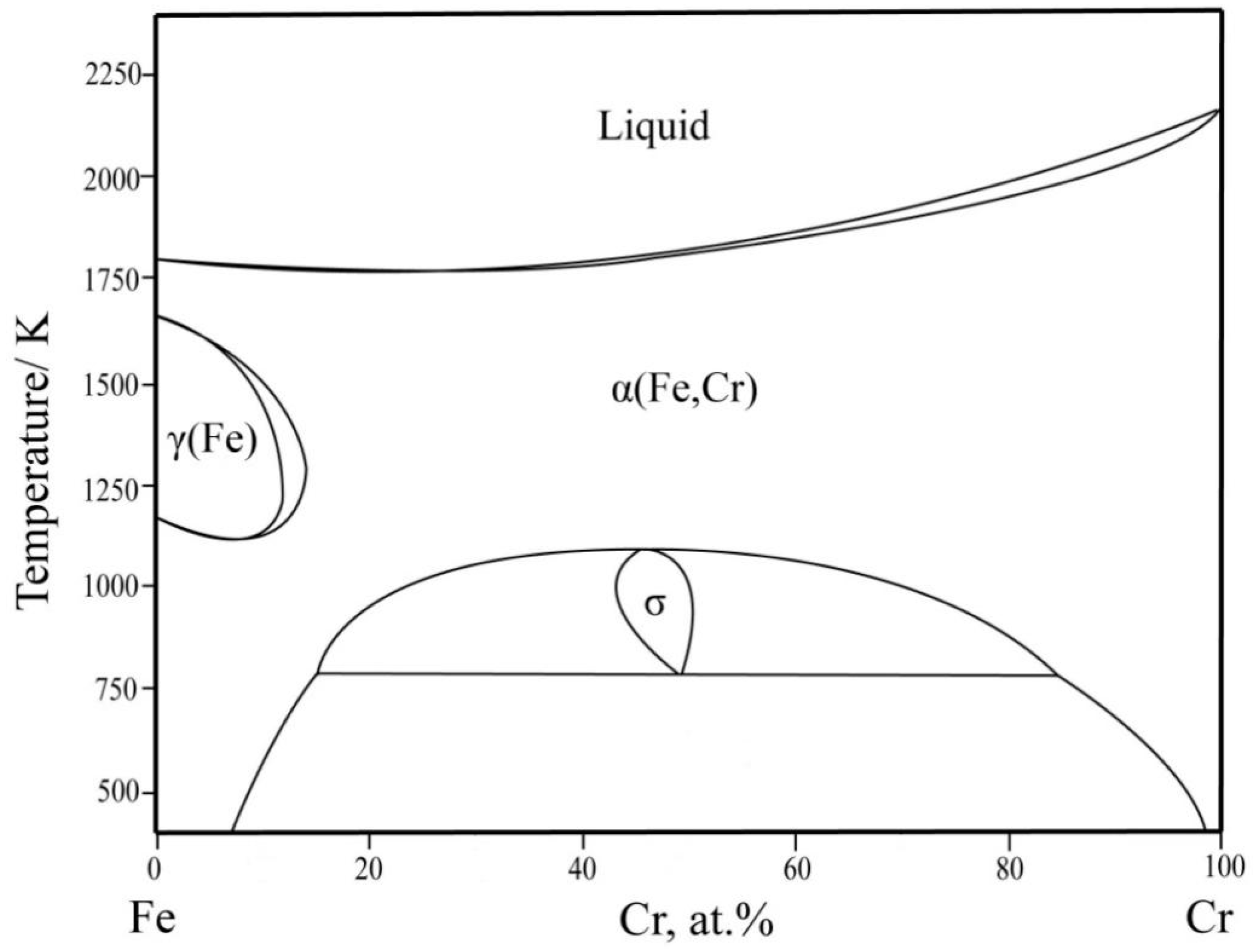

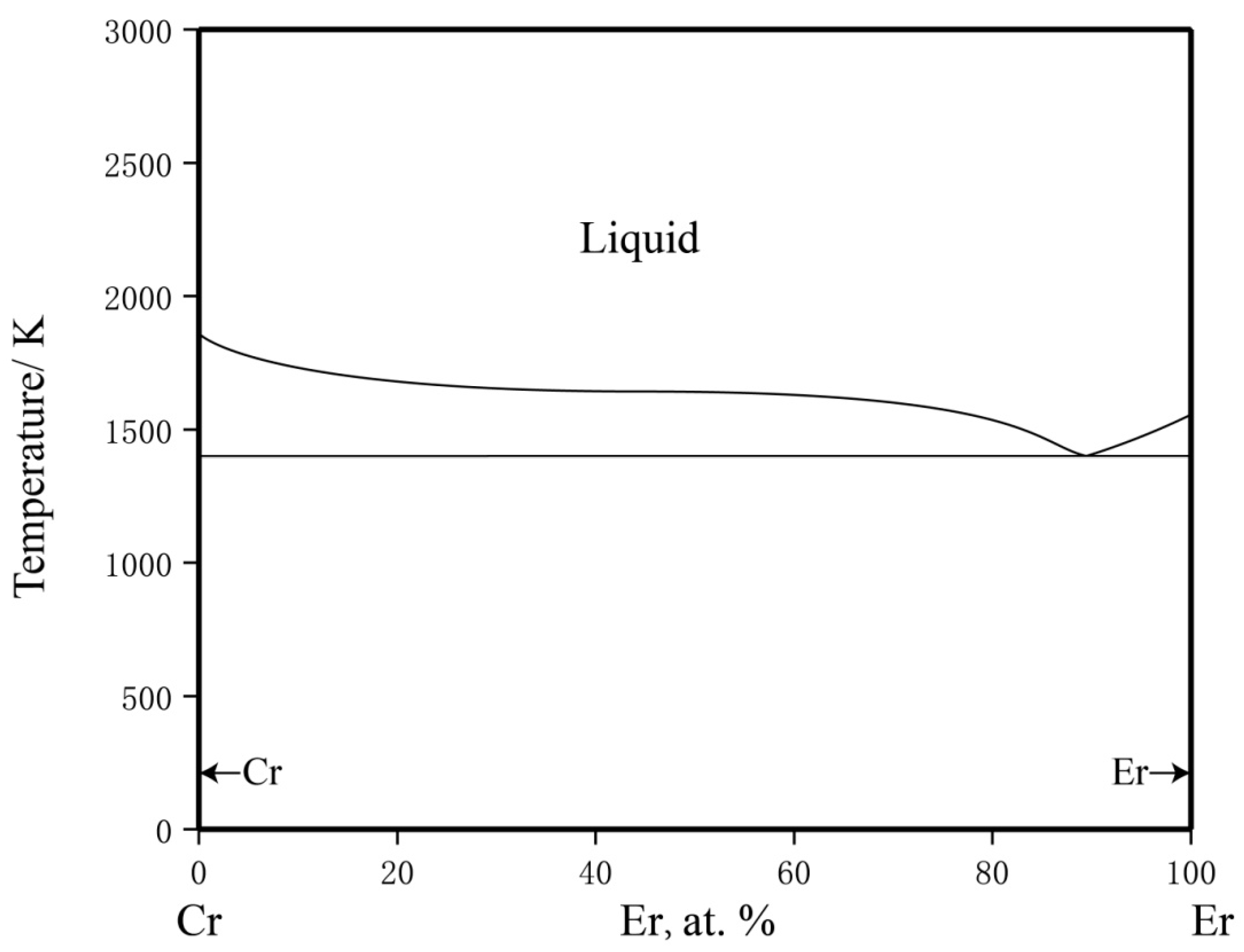
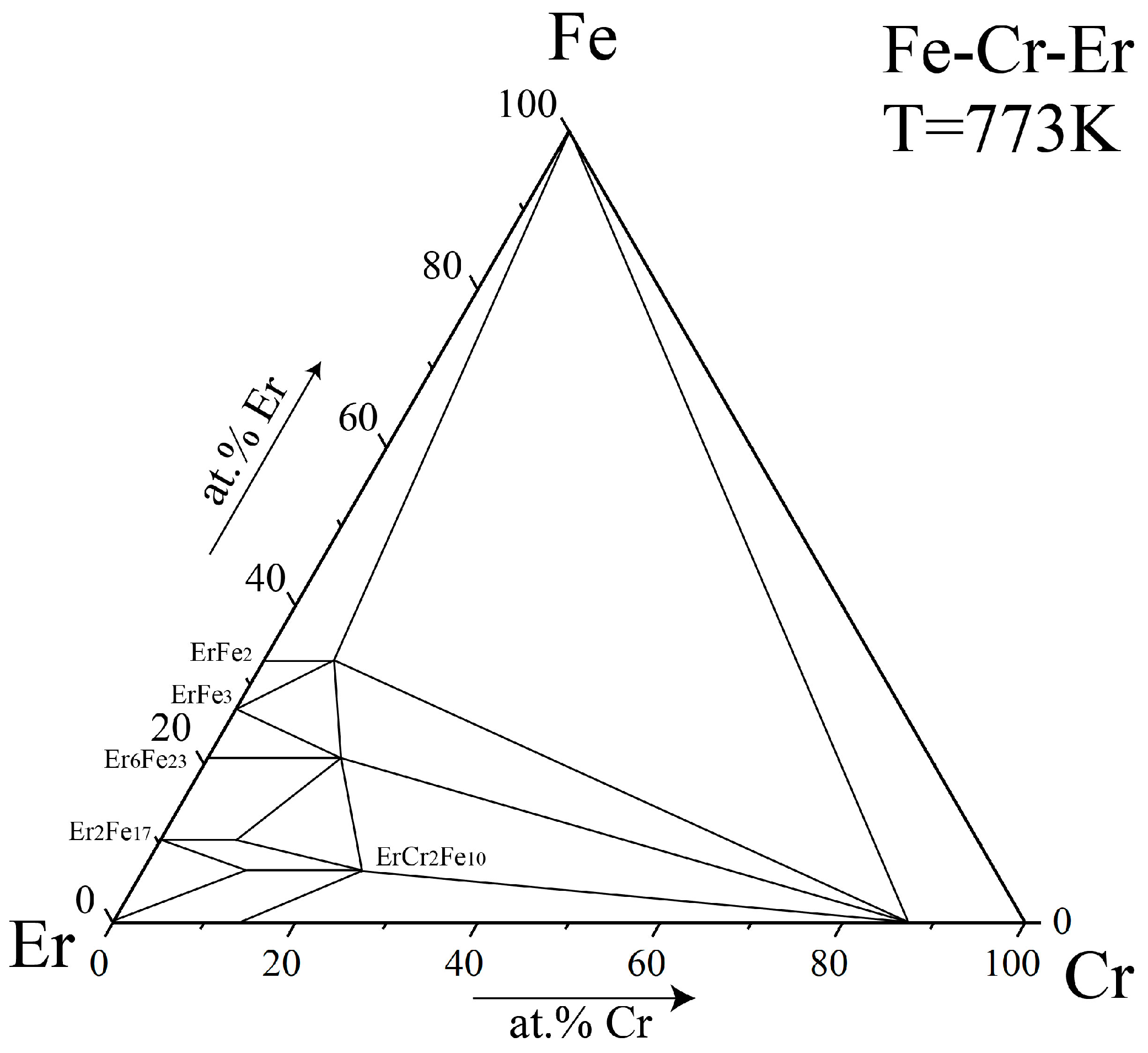

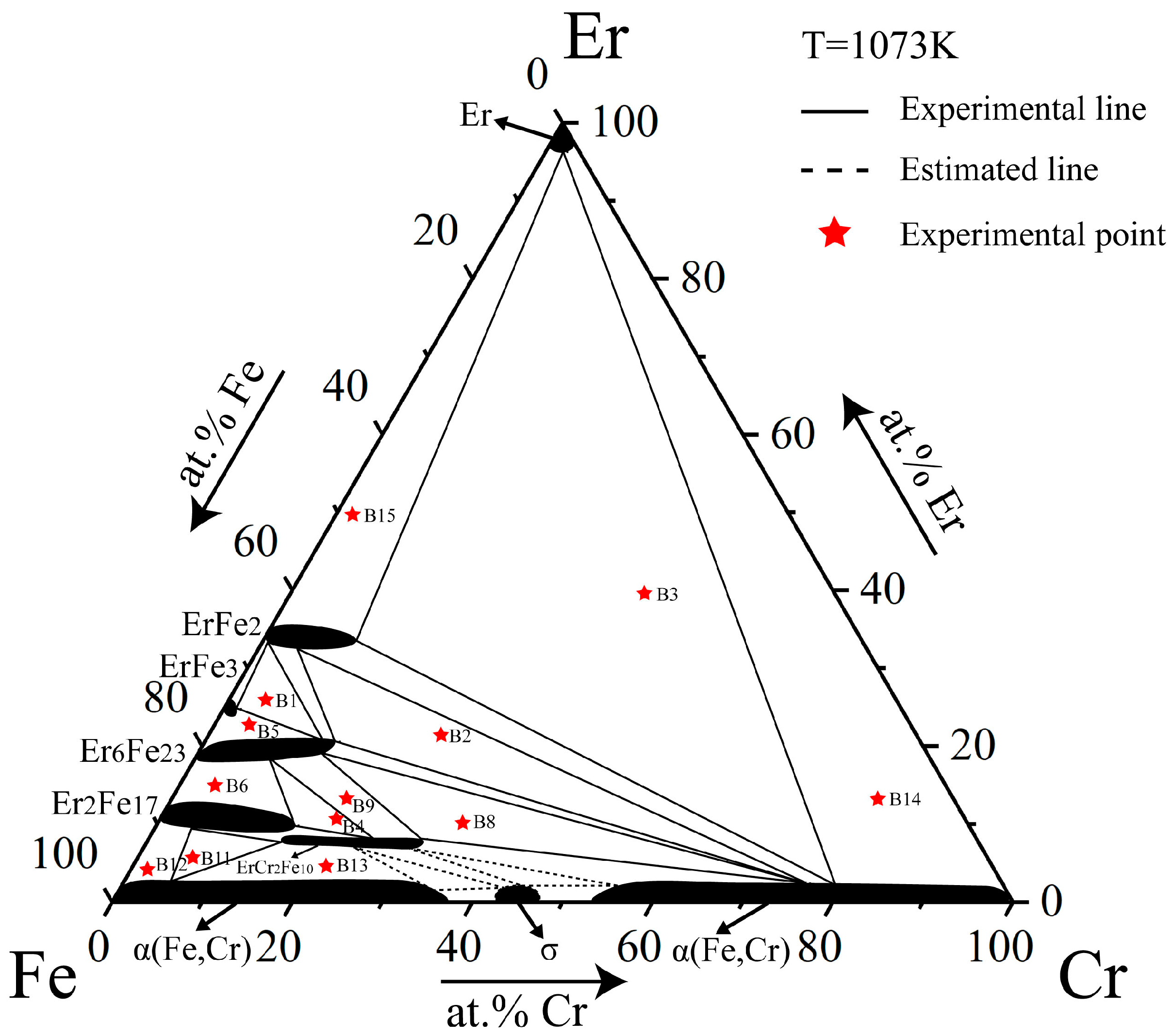
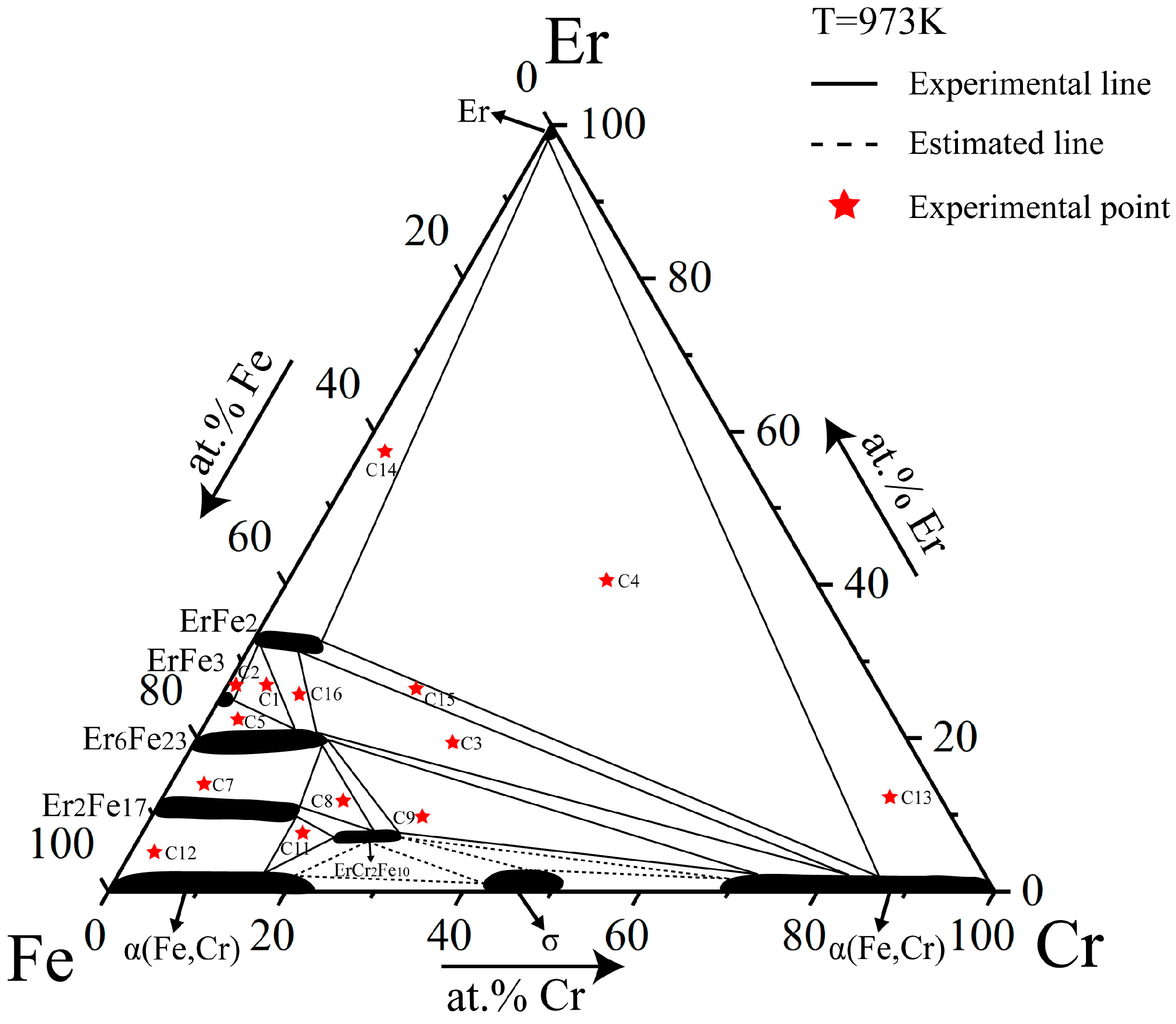
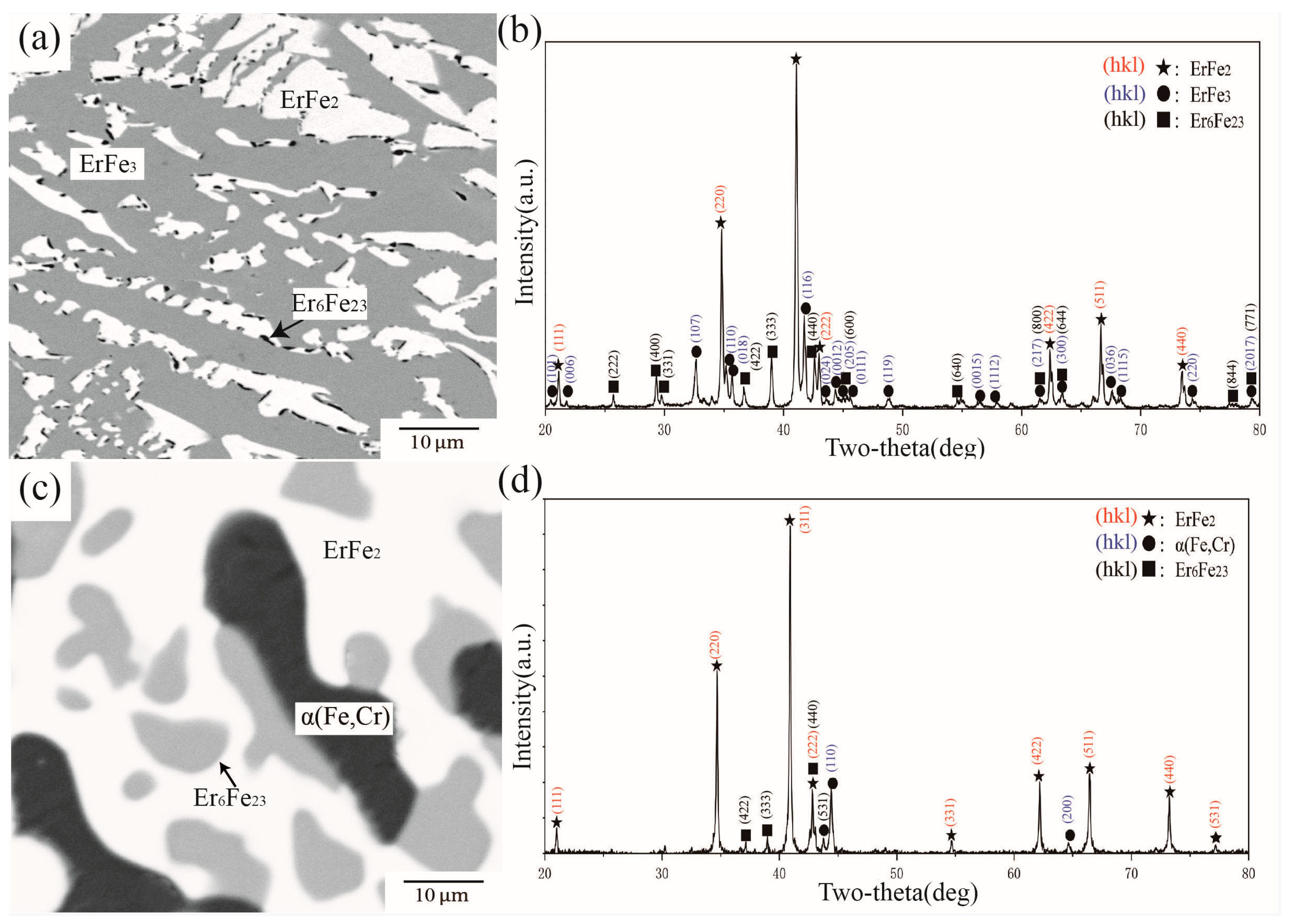
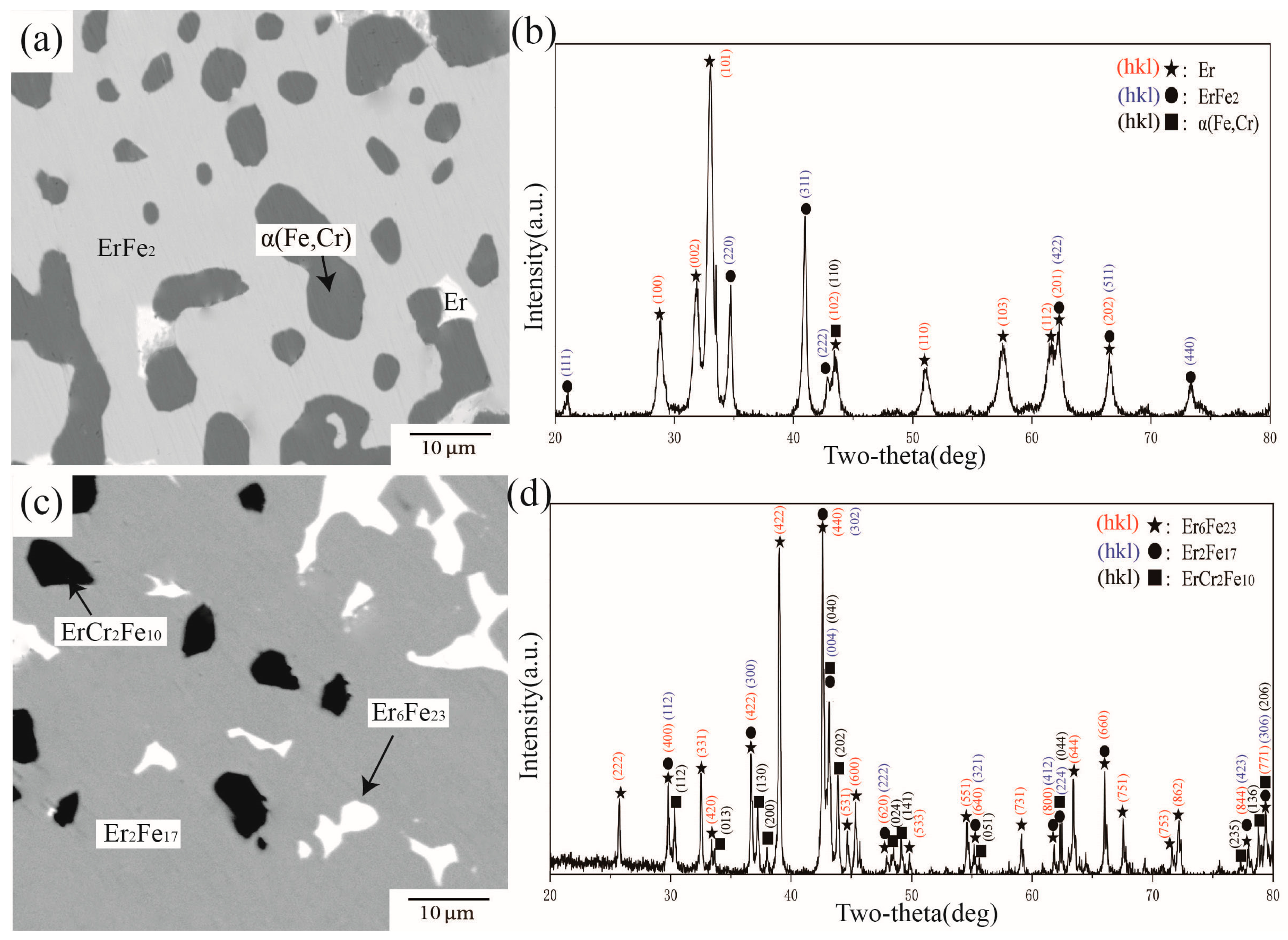

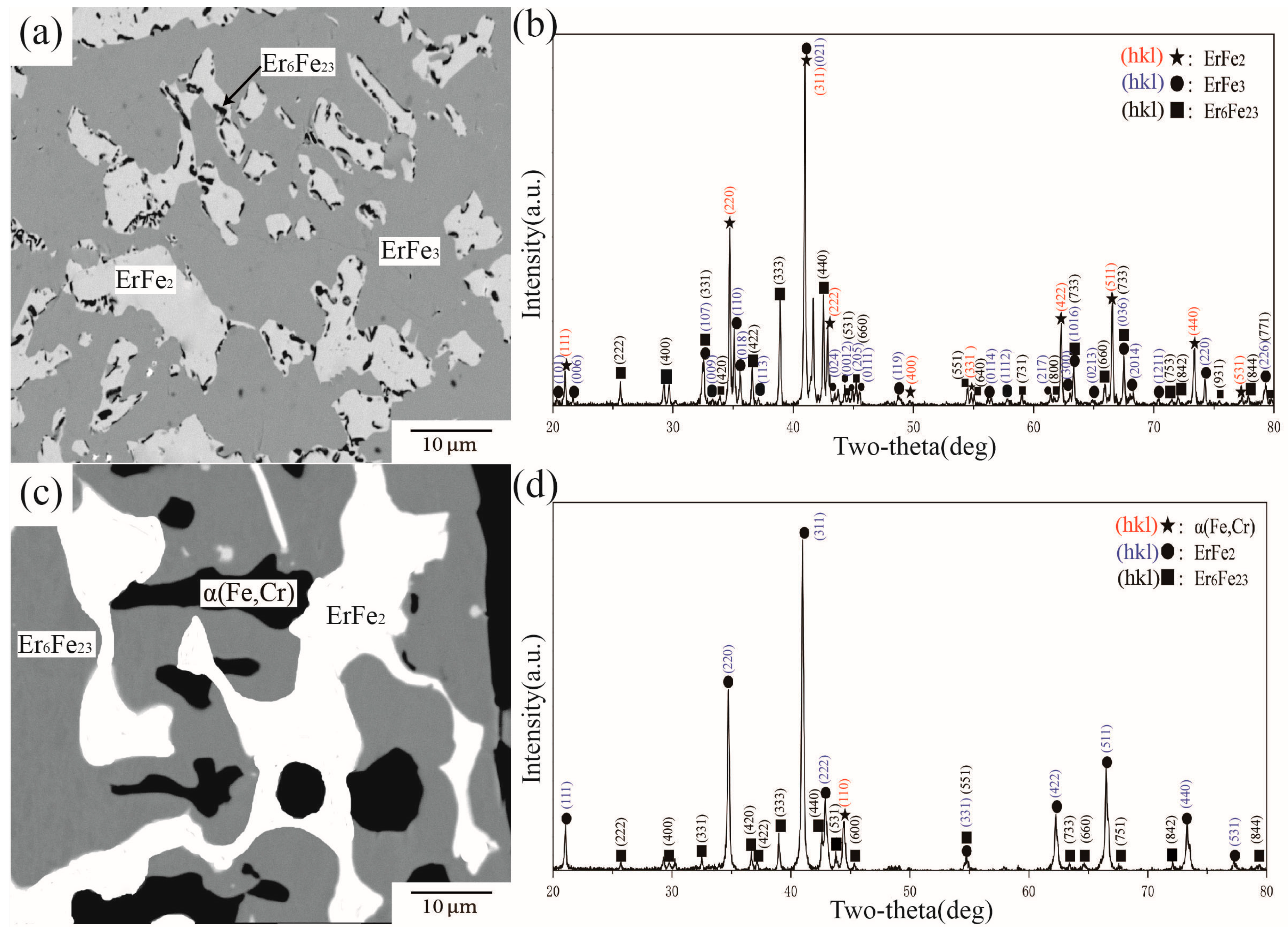

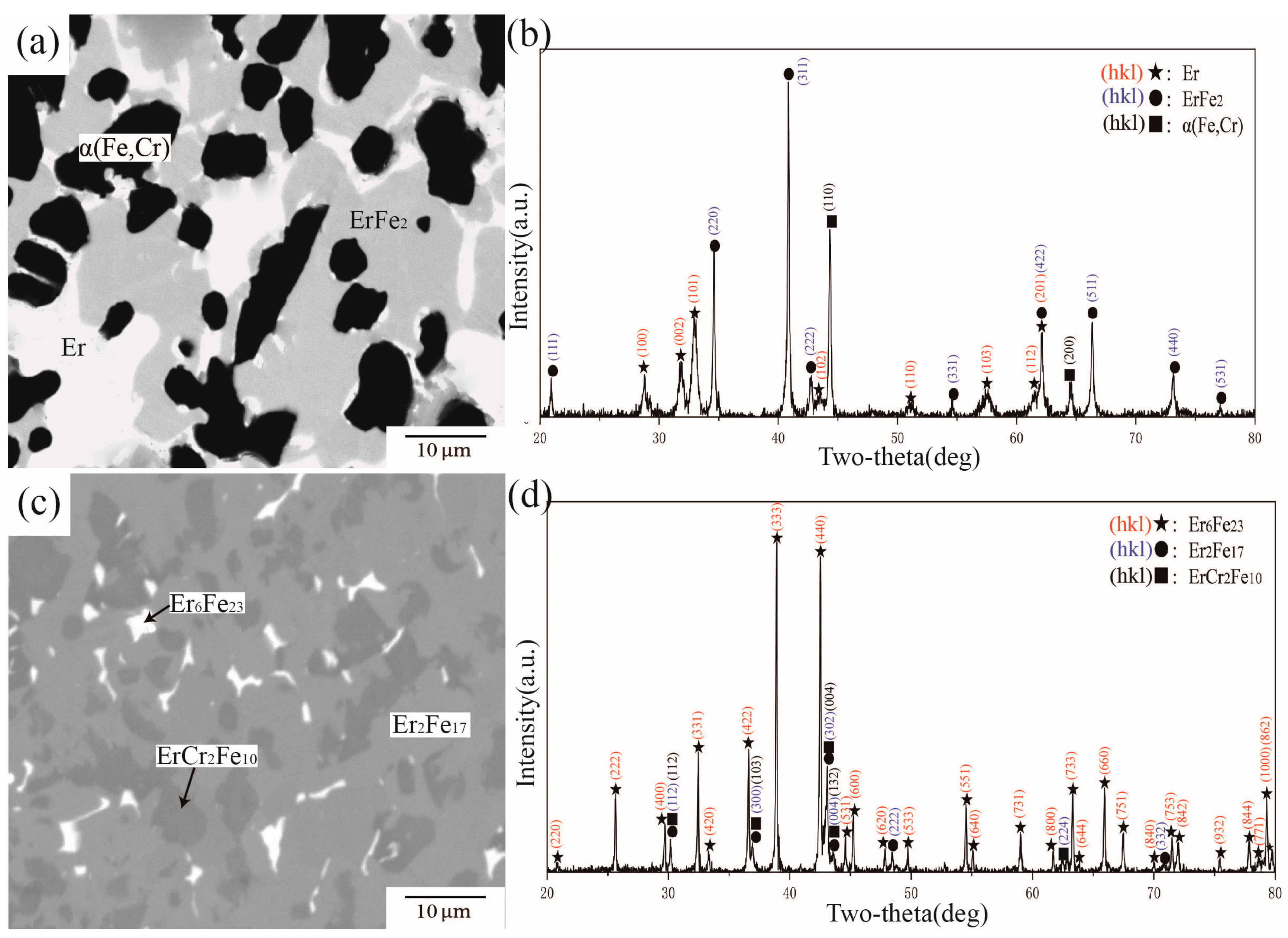
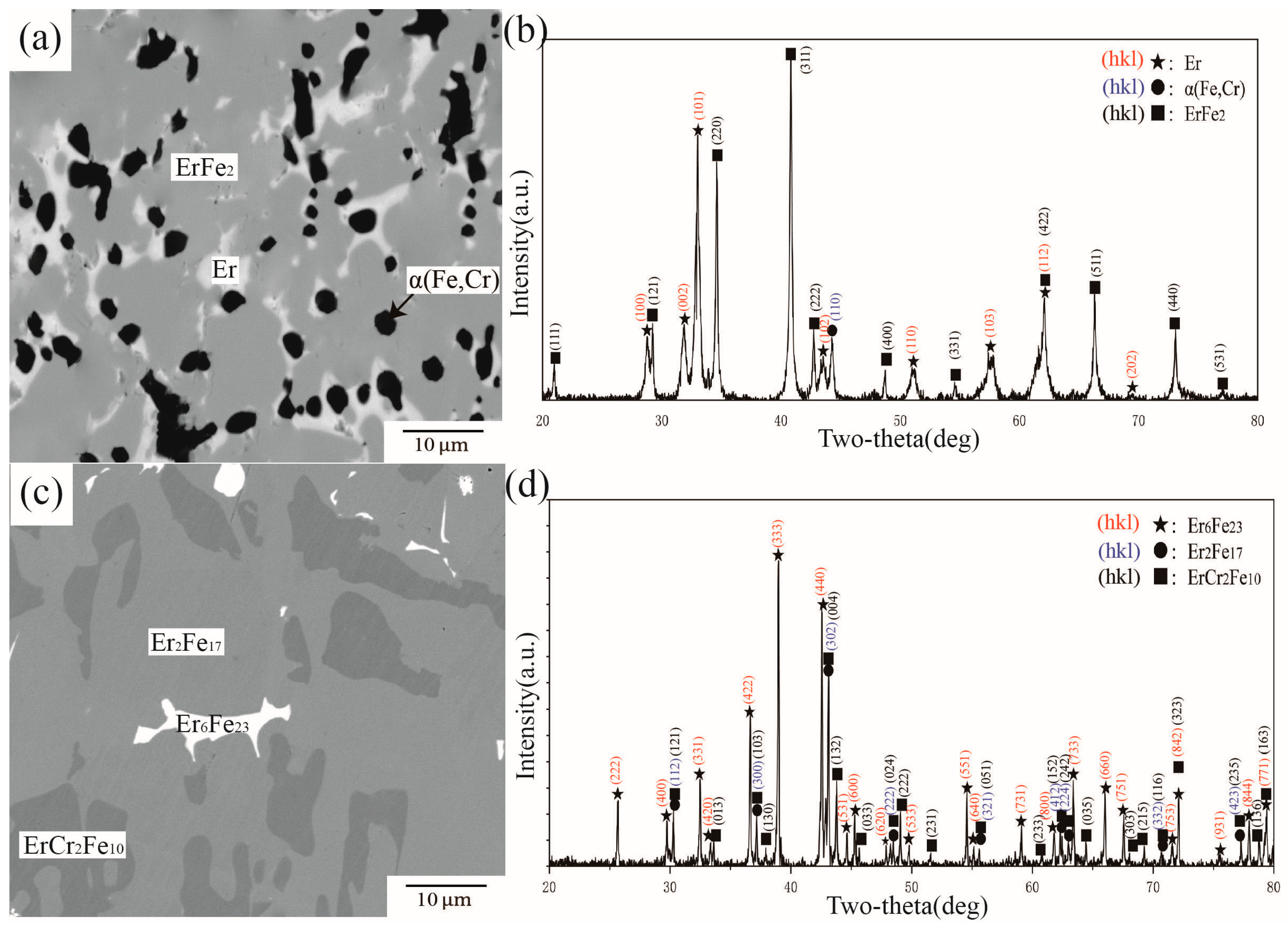
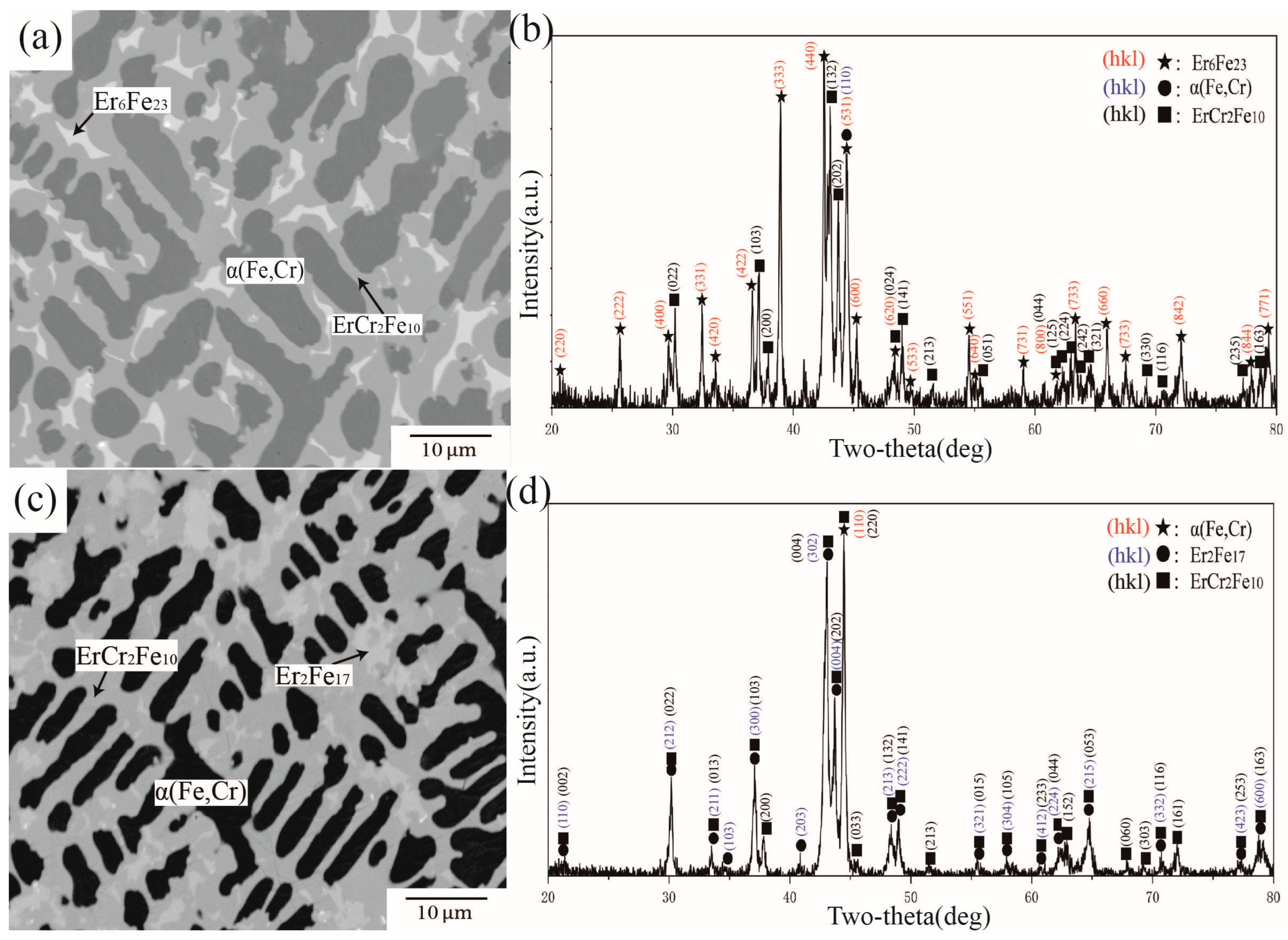
| Phase | Phase Prototype | Space Group | Lattice Parameters (nm) | Reference | ||
|---|---|---|---|---|---|---|
| a | b | c | ||||
| αFe | cI2 | 0.2862 | 0.2862 | 0.2862 | [1] | |
| γFe | cF4 | 0.3613 | 0.3613 | 0.3613 | [1] | |
| Cr | cI2 | 0.2910 | 0.2910 | 0.2910 | [2] | |
| Er | hP2 | P63/mmc | 0.3555 | 0.3555 | 0.5584 | [15] |
| σ | tP30 | P42/mmm | 0.8802 | 0.8802 | 0.4548 | [35] |
| ErFe2 | cF24 | 0.7316 | 0.7316 | 0.7316 | [39] | |
| ErFe3 | hR36 | 0.5086 | 0.5086 | 24464 | [39] | |
| Er6Fe23 | cF116 | 1.1994 | 1.1994 | 1.1994 | [39] | |
| Er2Fe17 | hP38 | P63/mmc | 0.8444 | 0.8444 | 0.8268 | [39] |
| ErCr2Fe10 | t/26 | I4/mmm | 0.8534 | 0.8534 | 0.4761 | [46] |
| Er3Cr12-xFex | hP80 | P63/mmc | 0.8416 | 0.8416 | 0.8325 | [48] |
| Alloys No. | Nominal Composition (at.%) | Experimental Results (at.%) | Phase Determination | ||||
|---|---|---|---|---|---|---|---|
| Fe | Cr | Er | Fe | Cr | Er | ||
| A1 | 40 | 5 | 55 | 46.92 | 15.26 | 37.82 | ErFe2 |
| 1.57 | 0.55 | 97.88 | Er | ||||
| A2 | 70 | 5 | 25 | 67.56 | 11.73 | 20.71 | Er6Fe23 |
| 73.8 | 1.72 | 24.48 | ErFe3 | ||||
| 63.44 | 3.56 | 33 | ErFe2 | ||||
| A3 | 70 | 2 | 28 | 63.04 | 2.35 | 34.61 | ErFe2 |
| 74.01 | 1.07 | 24.92 | ErFe3 | ||||
| A4 | 65 | 10 | 25 | 57.89 | 11.72 | 30.39 | ErFe2 |
| 61.67 | 16.87 | 21.46 | Er6Fe23 | ||||
| A5 | 59 | 11 | 30 | 60.15 | 10.08 | 29.77 | ErFe2 |
| A6 | 53 | 25 | 22 | 11.15 | 86.07 | 2.78 | α(Fe,Cr) |
| 62.15 | 7.82 | 30.03 | ErFe2 | ||||
| A7 | 60 | 20 | 20 | 61.72 | 18.34 | 19.94 | Er6Fe23 |
| 61.89 | 6.94 | 31.17 | ErFe2 | ||||
| 21.56 | 75.93 | 2.51 | α(Fe,Cr) | ||||
| A8 | 20 | 40 | 40 | 52.53 | 14.8 | 32.67 | ErFe2 |
| 1.21 | 4.48 | 94.31 | Er | ||||
| 5.03 | 92.03 | 2.94 | α(Fe,Cr) | ||||
| A9 | 70 | 8 | 22 | 73.92 | 2.47 | 24.61 | ErFe3 |
| 70.18 | 8.69 | 21.13 | Er6Fe23 | ||||
| A10 | 73 | 10 | 18 | 72.43 | 9.7 | 17.87 | Er6Fe23 |
| A11 | 80 | 5 | 15 | 68.86 | 10.11 | 21.03 | Er6Fe23 |
| 85.61 | 3.32 | 11.07 | Er2Fe17 | ||||
| A12 | 68 | 20 | 12 | 64.22 | 28 | 7.78 | ErCr2Fe10 |
| 69.81 | 13.46 | 16.73 | Er6Fe23 | ||||
| 71.95 | 18.32 | 9.73 | Er2Fe17 | ||||
| A13 | 56 | 35 | 9 | 66.75 | 16.75 | 16.5 | Er6Fe23 |
| 57.43 | 34.99 | 7.58 | ErCr2Fe10 | ||||
| 26.63 | 71.08 | 2.29 | α(Fe,Cr) | ||||
| A14 | 65 | 25 | 10 | 67.74 | 15.76 | 16.5 | Er6Fe23 |
| 61.81 | 30.86 | 7.33 | ErCr2Fe10 | ||||
| A15 | 83 | 5 | 12 | 84.16 | 4.61 | 11.23 | Er2Fe17 |
| A16 | 85 | 10 | 5 | 86.72 | 4.57 | 8.71 | Er2Fe17 |
| 78.11 | 15.02 | 6.87 | ErCr2Fe10 | ||||
| 87 | 10.02 | 2.98 | γFe | ||||
| A17 | 93 | 2 | 5 | 94.74 | 2.28 | 2.98 | γFe |
| 88.78 | 2.28 | 8.94 | Er2Fe17 | ||||
| A18 | 71 | 25 | 4 | 68.35 | 24.26 | 7.39 | ErCr2Fe10 |
| 80.02 | 17.88 | 2.1 | α(Fe,Cr) | ||||
| A19 | 57 | 27 | 16 | 63.88 | 18.24 | 17.87 | Er6Fe23 |
| 23.67 | 74.08 | 2.25 | α(Fe,Cr) | ||||
| A20 | 2 | 92 | 6 | 2.85 | 95.31 | 1.83 | α(Fe,Cr) |
| 0.65 | 5.41 | 93.94 | Er | ||||
| Alloys No. | Nominal Composition (at.%) | Experimental Results (at.%) | Phase Determination | ||||
|---|---|---|---|---|---|---|---|
| Fe | Cr | Er | Fe | Cr | Er | ||
| B1 | 70 | 5 | 25 | 64.6 | 13.49 | 20.01 | Er6Fe23 |
| 73.26 | 1.81 | 24.93 | ErFe3 | ||||
| 65.65 | 1.04 | 33.31 | ErFe2 | ||||
| B2 | 50 | 30 | 20 | 64.6 | 14.85 | 20.55 | Er6Fe23 |
| 62.87 | 4.54 | 32.59 | ErFe2 | ||||
| 21.71 | 75.74 | 2.55 | α(Fe,Cr) | ||||
| B3 | 20 | 40 | 40 | 55.96 | 10.48 | 33.56 | ErFe2 |
| 1.42 | 2.45 | 96 | Er | ||||
| 17.66 | 80.11 | 2.23 | α(Fe,Cr) | ||||
| B4 | 70 | 20 | 10 | 66.82 | 25.09 | 8.09 | ErCr2Fe10 |
| 74.93 | 15.22 | 9.85 | Er2Fe17 | ||||
| 72.94 | 8.56 | 18.5 | Er6Fe23 | ||||
| B5 | 73 | 4 | 23 | 72.43 | 6.34 | 21.22 | Er6Fe23 |
| 74.37 | 1.44 | 24.19 | ErFe3 | ||||
| B6 | 80 | 5 | 15 | 77.55 | 4.3 | 18.15 | Er6Fe23 |
| 82.91 | 4.2 | 12.89 | Er2Fe17 | ||||
| B7 | 68 | 20 | 12 | 66.4 | 25.71 | 7.89 | ErCr2Fe10 |
| 73.26 | 8.35 | 18.39 | Er6Fe23 | ||||
| 72.43 | 17.77 | 9.8 | Er2Fe17 | ||||
| B8 | 56 | 35 | 9 | 66.3 | 14.17 | 19.53 | Er6Fe23 |
| 61.13 | 30.9 | 7.97 | ErCr2Fe10 | ||||
| 22.69 | 74.92 | 2.39 | α(Fe,Cr) | ||||
| B9 | 67 | 20 | 13 | 68.81 | 12.45 | 18.75 | Er6Fe23 |
| 64.93 | 27.27 | 7.8 | ErCr2Fe10 | ||||
| B10 | 83 | 5 | 12 | 84.25 | 4.68 | 11.07 | Er2Fe17 |
| B11 | 90 | 5 | 5 | 85.98 | 4.8 | 9.22 | Er2Fe17 |
| 77.01 | 15.38 | 7.61 | ErCr2Fe10 | ||||
| 91.43 | 5.71 | 2.85 | α(Fe,Cr) | ||||
| B12 | 93 | 2 | 5 | 95.07 | 2.08 | 2.85 | α(Fe,Cr) |
| 88.02 | 1.78 | 10.2 | Er2Fe17 | ||||
| B13 | 75 | 20 | 5 | 72.04 | 20.61 | 7.35 | ErCr2Fe10 |
| 76.29 | 20.71 | 3 | α(Fe,Cr) | ||||
| B14 | 8 | 80 | 12 | 7.99 | 90.06 | 1.95 | α(Fe,Cr) |
| 0.39 | 2.73 | 96.87 | Er | ||||
| B15 | 48 | 2 | 50 | 2.16 | 1.12 | 96.72 | Er |
| 61.05 | 3.15 | 35.8 | ErFe2 | ||||
| Alloys No. | Nominal Composition (at.%) | Experimental Results (at.%) | Phase Determination | ||||
|---|---|---|---|---|---|---|---|
| Fe | Cr | Er | Fe | Cr | Er | ||
| C1 | 70 | 5 | 25 | 68.13 | 11.09 | 20.78 | Er6Fe23 |
| 72.92 | 2.21 | 24.87 | ErFe3 | ||||
| 67.08 | 1.02 | 31.9 | ErFe2 | ||||
| C2 | 72 | 1 | 27 | 67.31 | 0.51 | 32.18 | ErFe2 |
| 73.04 | 1.11 | 25.86 | ErFe3 | ||||
| C3 | 50 | 30 | 20 | 66.15 | 13.21 | 20.64 | Er6Fe23 |
| 63.24 | 5.7 | 31.05 | ErFe2 | ||||
| 15.39 | 82.75 | 1.85 | α(Fe,Cr) | ||||
| C4 | 25 | 35 | 40 | 59.15 | 7.5 | 33.35 | ErFe2 |
| 1.41 | 0.77 | 97.82 | Er | ||||
| 12.21 | 85.66 | 2.13 | α(Fe,Cr) | ||||
| C5 | 75 | 3 | 22 | 74.32 | 1.65 | 24.03 | ErFe3 |
| 75.57 | 3.63 | 20.8 | Er6Fe23 | ||||
| C6 | 73 | 10 | 18 | 71.59 | 10.87 | 17.54 | Er6Fe23 |
| C7 | 80 | 5 | 15 | 78.65 | 3.78 | 17.56 | Er6Fe23 |
| 84.13 | 3.64 | 12.22 | Er2Fe17 | ||||
| C8 | 68 | 20 | 12 | 72.84 | 16.22 | 10.94 | ErCr2Fe10 |
| 67.46 | 13.73 | 18.81 | Er6Fe23 | ||||
| 73.48 | 16.23 | 10.28 | Er2Fe17 | ||||
| C9 | 60 | 30 | 10 | 67.06 | 13.28 | 19.66 | Er6Fe23 |
| 63.62 | 28.64 | 7.74 | ErCr2Fe10 | ||||
| 25.67 | 72.32 | 2.01 | α(Fe,Cr) | ||||
| C10 | 83 | 5 | 12 | 83.43 | 5.19 | 11.38 | Er2Fe17 |
| C11 | 74 | 18 | 8 | 73.91 | 16.56 | 9.53 | Er2Fe17 |
| 71.16 | 21.84 | 7 | ErCr2Fe10 | ||||
| 80.77 | 16.58 | 2.65 | α(Fe,Cr) | ||||
| C12 | 93 | 2 | 5 | 94.9 | 2.71 | 2.39 | α(Fe,Cr) |
| 88.51 | 1.93 | 9.55 | Er2Fe17 | ||||
| C13 | 5 | 83 | 12 | 6.65 | 91.79 | 1.56 | α(Fe,Cr) |
| 0.47 | 1.29 | 98.24 | Er | ||||
Disclaimer/Publisher’s Note: The statements, opinions and data contained in all publications are solely those of the individual author(s) and contributor(s) and not of MDPI and/or the editor(s). MDPI and/or the editor(s) disclaim responsibility for any injury to people or property resulting from any ideas, methods, instructions or products referred to in the content. |
© 2023 by the authors. Licensee MDPI, Basel, Switzerland. This article is an open access article distributed under the terms and conditions of the Creative Commons Attribution (CC BY) license (https://creativecommons.org/licenses/by/4.0/).
Share and Cite
Li, C.; Nie, Y.; Yin, R.; Yang, J.; Ye, L.; Liu, L.; Zhang, L. Phase Equilibria of the Fe–Cr–Er Ternary System in the Range 973–1273 K. Materials 2023, 16, 1705. https://doi.org/10.3390/ma16041705
Li C, Nie Y, Yin R, Yang J, Ye L, Liu L, Zhang L. Phase Equilibria of the Fe–Cr–Er Ternary System in the Range 973–1273 K. Materials. 2023; 16(4):1705. https://doi.org/10.3390/ma16041705
Chicago/Turabian StyleLi, Chenbo, Yusong Nie, Rong Yin, Jifeng Yang, Lideng Ye, Libin Liu, and Ligang Zhang. 2023. "Phase Equilibria of the Fe–Cr–Er Ternary System in the Range 973–1273 K" Materials 16, no. 4: 1705. https://doi.org/10.3390/ma16041705
APA StyleLi, C., Nie, Y., Yin, R., Yang, J., Ye, L., Liu, L., & Zhang, L. (2023). Phase Equilibria of the Fe–Cr–Er Ternary System in the Range 973–1273 K. Materials, 16(4), 1705. https://doi.org/10.3390/ma16041705






